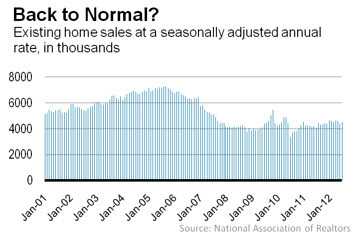By Kathleen Madigan
Housing continues its slow creep toward
stability. Normalcy is a long way off.
The National Association of Realtors announced July sales of existing homes
rose to an annual rate of 4.47 million, close to expectations.
Interestingly, the NAR says sales could be even
higher: “The market is constrained by unnecessarily tight lending standards and
shrinking inventory supplies, so housing could easily be much stronger without
these abnormal frictions.”
What would be normal? The NAR said current
demographics would support existing home sales in the 5.0-5.5 million range if
conditions were optimal.
But of course, conditions are not. First-time
and move-up buyers are restrained by tight lending standards and weak job
growth.
Investors are stepping into the breach. Their
purchases of homes reflect the shift from owning to renting among U.S.
In July, investors bought 16% of homes sold.
That’s on the low end of their share of sales over the past two years but
that’s not because of less interest.
Instead, it’s because speculators are finding
fewer bargains to buy. Distressed homes–foreclosures and short sales sold at
deep discounts–accounted for 24% of July sales, down from 29% a year earlier.
Fewer cheap homes, in turn, helped to push up
the median price of the existing homes sold. It rose to $187,000, a 9.4% jump
from year-ago levels. Better prices should draw more homes onto the market.
“Persistent news of a solid floor in home prices
should help the recovery in organic turnover as selling conditions continue to
improve,” say economists at Credit Suisse.
Sales are sales, so investor interest helps
overall housing demand. But the financial lift to the average U.S.
Since the jump in the NAR median price reflects
a change in the mix of homes sold, homeowners in a community with few
foreclosures aren’t seeing their home equity rising at nearly double-digit
rates. Home price indexes that adjust for housing mix are showing no gain in
prices.
Consequently, U.S.
However, expectations for only modest gains in
consumer spending is why a stable housing market is good news for an economy
that needs all the positive trends it can get.
For more information about sea Isle city real estate or Cape May County real estate check us out on line www.LandisCo.com .
Email us at info@LandisCo.com or toll free at (888)SEA-ISLE

No comments:
Post a Comment